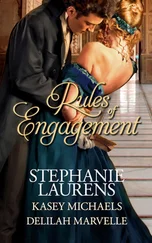Elizabeth Moon - Rules of Engagement
Здесь есть возможность читать онлайн «Elizabeth Moon - Rules of Engagement» весь текст электронной книги совершенно бесплатно (целиком полную версию без сокращений). В некоторых случаях можно слушать аудио, скачать через торрент в формате fb2 и присутствует краткое содержание. Жанр: Космическая фантастика, Боевая фантастика, на английском языке. Описание произведения, (предисловие) а так же отзывы посетителей доступны на портале библиотеки ЛибКат.
- Название:Rules of Engagement
- Автор:
- Жанр:
- Год:неизвестен
- ISBN:нет данных
- Рейтинг книги:4 / 5. Голосов: 1
-
Избранное:Добавить в избранное
- Отзывы:
-
Ваша оценка:
- 80
- 1
- 2
- 3
- 4
- 5
Rules of Engagement: краткое содержание, описание и аннотация
Предлагаем к чтению аннотацию, описание, краткое содержание или предисловие (зависит от того, что написал сам автор книги «Rules of Engagement»). Если вы не нашли необходимую информацию о книге — напишите в комментариях, мы постараемся отыскать её.
Rules of Engagement — читать онлайн бесплатно полную книгу (весь текст) целиком
Ниже представлен текст книги, разбитый по страницам. Система сохранения места последней прочитанной страницы, позволяет с удобством читать онлайн бесплатно книгу «Rules of Engagement», без необходимости каждый раз заново искать на чём Вы остановились. Поставьте закладку, и сможете в любой момент перейти на страницу, на которой закончили чтение.
Интервал:
Закладка:
The littles were so dirty—she couldn’t tell which were smudges and which were bruises. As they finished their sweetbars, she herded them into the bathroom, and used the towels and soap to clean them up. Then she got them all dressed, as much as possible, and folded the rest of the clothes. Four more shirts, four more jumpsuits . . . three sets for each child, if only they’d been complete. And for herself . . . nothing but a long-sleeved pullover that was really Stinky’s; it had been in her compartment because she’d traded shirts with him, this last segment. She didn’t put it on because she had nothing to wear with it . . . the thought of wearing that on her top, and nothing below, was worse than nothing at all.
She stacked the clothes neatly in one corner, and put the food in another. She let the children sort through the toys. Brandy chose blocks, as always; Stassi hugged her doll to her chest, fiercely. Paolo began handing blocks to Brandy, while Dris put the other doll in the groundcar and rolled it along the floor.
The hatch slammed open, startling her; she almost looked up but remembered in time. The littles did look up, but quickly glanced away, toward her.
“Why aren’t you dressed, girlie?”
She must not speak. She didn’t know how to answer without speaking. She shook her head, spread her hands.
The boots moved closer, the big hands tossed aside the neat stack she’d made of the clothes, and came up with Stinky’s pullover. The man threw it at her. “Put this on, girlie. Now.”
She fumbled her way into it. “You wrap yourself in one of them sheets.” She hadn’t thought of that; she scrambled across the deck, grabbed a sheet, and wrapped it clumsily around her body. How could she make it stay? Something thumped on the deck in front of her—a small canvas bag. “That’s a sewing kit—if you can’t sew, better learn. Make yourself something decent from the sheets. Cover your arms, everything to the ankles. Don’t make the skirt too full. Only decent married women wear full skirts. Make them girl babies skirts too; sew ’em to their shirts.” He walked around, stood over the littles.
“What’s this?” She didn’t look up; didn’t answer. “Now girlie, you got to teach these babies right. Girls play with girls; boys play with boys. Girls got dolls; boys got boys’ toys. You keep ’em separate, you hear?”
But Brandy and Paolo were friends; they’d played together since infancy. And Brandy always played with blocks and building toys. Hazel crouched, scared and furious both, as the man knocked down Brandy’s block tower, and moved her near her sister. “You—take this doll.” Brandy took it, but Hazel could see the anger in her eyes, almost enough to overcome the fear. Paolo, left with the scattered blocks, had already picked one up and was reaching toward Brandy. “No!” the man said. “No blocks for girls. Blocks for boys.” Paolo looked puzzled, but Brandy let out a furious screech. Casually, the man slapped her against the bulkhead. “Shut up—you better learn now, sissie.”
The next days were, if possible, a worse nightmare. The littles could not understand any of the restrictions; Hazel struggled to keep them separated as the raiders demanded, to keep them engaged with “appropriate” toys, to keep the compartment clean enough, herself “decent,” and still figure out how to make the garments the raiders demanded she furnish for herself and the girls. She had never sewn anything in her life; she had seen Donya using the sewing machine to create artworks they sold when they stopped at Corian, but clothes came from shops, or—in emergencies—the fabricator. You put in the measurements, dialled the style, and out came clothes. She had no idea how to turn flat cloth into the tubelike garment in the picture the raiders showed her.
It wasn’t a practical garment anyway. Snug tubes for the arms, a long one covering her from armpits to ankles . . . no one could sit comfortably, walk comfortably, climb and play and do things in a shape like that. But she didn’t argue. She struggled to figure out the odd implements in the sewing kit: dangerous thin sharp bits of metal that had no place around small children, reels of fine thread, scissors, a long tape marked off in sections that corresponded to no measuring system she knew, a short metal strip—also marked in sections—with a sliding part.
Sewing by hand was much harder than it looked, though when she figured out that the tiny cup-shaped thing would fit over her finger and protect it from pricks of the long sharp thing that the thread fit through, she got along better. The fabric seemed to have a mind of its own; it shifted around as she tried to poke through it. But finally she had a long straight skirt attached to the bottom of her pullover, and skirts on the girls’ shirts. They hated them, and pulled them up around their waists to play . . . but that, it turned out, was something else forbidden to girls.
“You were reared among heathen,” the man said. “We know that, and we make allowances for it. But you’re among decent folk now, and you must learn to act like decent folk. It is forbidden for any female to show herself off to men; these girl babies must be decently covered at all times.”
Then why, Hazel wanted to scream, won’t you let us have underwear? Long pants? And how can you call a toddler playing on the floor a female showing herself off to men? She said nothing, but bobbed her head. She had to protect the littles, and she could do that only by being there—being able to sing them to sleep, to comfort them in a murmur that grew softer day by day.
She had no idea how much time had passed when the daily visitor first took the boys out of the compartment. By then, of course the raiders knew all the children’s names. At first, Paolo and Dris hung back . . . but the man simply gathered them up and carried them out. Hazel was terrified—what would they do to the boys? But in the time it took to feed the girls their lunch, the boys were back, grinning from ear to ear. Each held a new toy—Paolo had a toy spaceship, and Dris had a set of brightly colored beads.
“We had fun,” Dris said. Hazel shushed him, but Paolo spoke up.
“We can talk. They said so. Boys can talk all they want. It’s only girls have to be quiet.”
Brandy scowled. “Gimme!”
“No,” Paolo said. “This is mine. Girls can’t play with boys’ toys.” Brandy burst into tears.
After that, day by day, the boys were weaned away from the girls. Daily visits outside the compartment—they returned with glowing reports: they could run up and down the corridors; they could use the swings in the gym; they could use the computer in the schoolroom. The men fed them special foods, treats. The men were teaching them. The men read to them from books, new books, stories about animals and boys and exciting stuff. They were gone hours a day now, returning to the compartment only for baths and bed. Hazel was left with the girls, the two dolls, and the endless sewing.
“You teach those girl babies to sew,” Hazel was told. “They’re old enough for that.”
They didn’t want to learn, but that made no difference. Hazel realized that. But . . . no books at all? No vid, no computers, no chance to run and play? She didn’t ask. She didn’t dare. She didn’t even dare tell them stories, the stories they knew, because the compartment was rigged for scan. She had been warned to talk no more than necessary . . . telling them stories would, she knew without asking, be breaking the rules.
The days dragged by. Stassi, though younger, was better with needle and thread than Brandy. Her stitches were ragged and uneven, but she could get them lined up into a sort of row. Brandy, more active by nature, fretted and fumed; her thread kept getting into knots. Hazel tried to find ways to let the child work off her wild energy, but in that small space, and hampered by a long skirt, the child was constantly being frustrated. She cried often, and had screaming tantrums at least once a day.
Читать дальшеИнтервал:
Закладка:
Похожие книги на «Rules of Engagement»
Представляем Вашему вниманию похожие книги на «Rules of Engagement» списком для выбора. Мы отобрали схожую по названию и смыслу литературу в надежде предоставить читателям больше вариантов отыскать новые, интересные, ещё непрочитанные произведения.
Обсуждение, отзывы о книге «Rules of Engagement» и просто собственные мнения читателей. Оставьте ваши комментарии, напишите, что Вы думаете о произведении, его смысле или главных героях. Укажите что конкретно понравилось, а что нет, и почему Вы так считаете.












